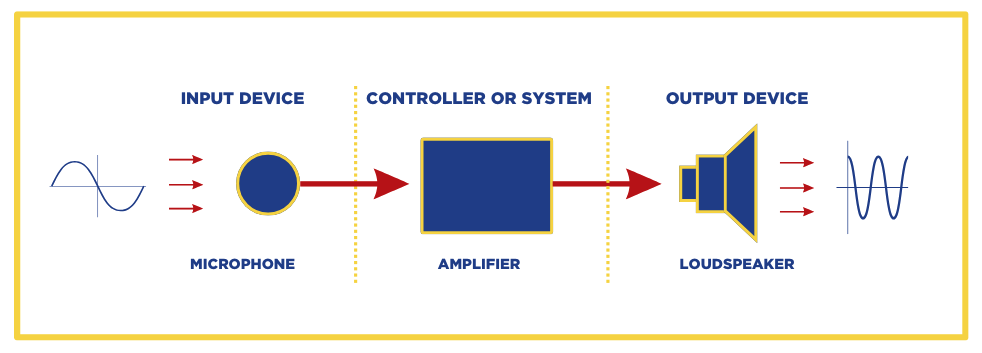What is a Transducer?

More from the Category
Transducers convert various forms of energy into electrical signals, which can be easily measured, processed, and controlled. This ability is essential in connecting the physical world with electronic systems, enabling the efficient interaction, measurement, and control of various physical properties.
What is a Transducer?
A transducer is an electronic component that transforms one form of energy into another. These components often convert physical properties (pressure, temperature, or sound) into an electrical signal or an electrical signal into a physical property.

Transducers are just one of many important electronic components. Learn more about other Essential Electronic Components!
How Transducers Work
Transducers convert energy using a sensing element and a transduction mechanism. Based on their working principles, they can be classified as resistive, capacitive, inductive, or optical.
Resistive Transducers: Detects changes in electrical resistance and presents them in an easily readable format, such as on a screen or dial.
Capacitive Transducers: Measure changes in capacitance (such as changes in the distance between the plates of a capacitor) and present the results in an easily readable format.
Inductive Transducers: Detect variations in inductance (the property of an electronic component) to oppose changes in the current flowing through it by generating a voltage. By measuring changes, inductive transducers can sense physical parameters and convert them into readable signals.
Optical Transducers: Use light to measure changes in energy and produce a measurable response.
Transducer Efficiency
Understanding efficiency in the context of transducers involves looking at how effectively a transducer can convert input energy into a specific form of output energy. This efficiency is determined by comparing the useful power output to the total power input.
How Efficiency is Defined: Efficiency measures the proportion of input energy that is successfully transformed into the desired output energy. It’s expressed as a ratio that ranges from 0 to 1.
Calculating Transducer Efficiency
- Identify Total Power Input: Denoted as P, this is the total energy fed into the transducer.
- Measure Desired Power Output: Represented as Q, this is the energy output in the form you want from the device.
- Compute Efficiency: The efficiency (E) can be calculated with the formula: [ E = \frac{Q}{P} ]
- This formula gives a ratio that easily indicates efficiency as a fraction. To express this efficiency percentage-wise, the formula is adjusted as follows:
[ E% = \left(\frac{Q}{P}ight) \times 100 ]
- These basic calculations allow for evaluating how well a transducer is converting input energy into desired output, offering insights into its performance and potential areas for improvement.
100 Percent Efficiency
Transducers can never reach 100 percent efficiency due to the intrinsic nature of energy conversion processes. During the transformation of one form of energy to another, some energy is inevitably lost. This lost energy most often dissipates as heat, a byproduct that cannot be entirely eliminated.
Here’s a breakdown of why this happens:
- • Energy Conservation Laws: According to the laws of thermodynamics, energy cannot be created or destroyed, only transformed. In this transformation, inefficiencies always occur.
- • Material Limitations: The materials used in transducers have inherent inefficiencies that prevent full energy conversion. They can’t perfectly conduct or convert energy without some loss.
- • Heat Generation: Whenever energy changes form, some of it will convert into heat. This heat disperses into the environment, reducing the efficiency of the process.
- • Mechanical and Electrical Losses: Friction, resistance, and other physical factors in mechanical and electrical systems contribute to energy loss.
Antennas and Incandescent Lamps
When assessing transducer efficiency, antennas and incandescent lamps present a striking contrast. An efficiently designed antenna can convert nearly the entire radio frequency (RF) power it receives into electromagnetic energy. For instance, if an antenna receives 100 watts of RF power, it may successfully convert 80 to 90 watts into an electromagnetic field. The remainder is usually lost as heat in the components like the antenna conductors, the feed line, and nearby objects.
In stark contrast, incandescent lamps are notably inefficient. A 100-watt bulb emits only a small fraction of its energy as visible light. Most of its power is wasted as heat, with a minor portion being released in the ultraviolet spectrum. This significant difference highlights why antennas are considered far superior as transducers, emphasizing their ability to effectively convert input energy into desired output with minimal power loss.
Types of Transducers
Now that we’ve answered the question “What is a transducer” let’s cover the different types of transducers.
Input Transducers
Input transducers, or sensors, convert physical energy such as sound, temperature, pressure, or light into a readable electrical signal.
Example: Microphones capture the physical sound waves and convert them into an electrical signal that can be transferred through wires to an amplifier.
Output Transducers
An output transducer or an actuator receives electrical signals and converts them into other forms of energy such as mechanical movement, light or heat.
Example: A lamp converts electricity into light, or a motor converts electricity into motion.

Specialized Transducers
Specialized transducers are designed for niche or high precision applications. These devices are engineered to measure very specific physical properties, often under demanding conditions, and deliver accurate, reliable performance for specialized industries.
Example: Ultrasound Transducers used in medical imaging convert electrical signals into sound waves and back, creating images of the inside of the body.
Applications of Transducers
The semiconductor transducer is essential across a broad range of applications, from every day and medical uses to industrial and scientific fields. These components effectively convert physical properties into precise, readable electrical signals.
Everyday Applications
Transducers are woven into the fabric of daily life, enabling many of the technologies we use without a second thought.
Speakers: Speakers convert electrical signals back into sound waves for audio playback
Remote Controls: Remotes used infrared transducers to send signals to devices
Touch Screens: Capacitive touch transducers detect touch inputs
Industrial and Scientific Applications
In industrial and research environments, transducers provide the precision and reliability needed for measurement, monitoring, and control.
Semiconductor Pressure Transducer: Pressure sensors monitor and control pressure in hydraulic and pneumatic systems
Accelerometers: Accelerometers measure forces in scientific research and industrial applications
Proximity Sensors: Proximity sensors detect the presence or absence of objects in assembly lines
Medical Applications
In healthcare, transducers are critical tools for diagnosis, monitoring, and treatment, helping professionals gather accurate data from the human body.
Ultrasound Transducers: Ultrasound transducers convert electrical signals into sound waves and back to create images of the inside of the body
MRI Coils: MRI coils convert magnetic resonance signals into images
Electrocardiogram (ECG) Sensors: ECG sensors measure the electrical activity of the heart
Innovative Applications
Emerging technologies and advanced fields rely on transducers to push boundaries, improve efficiency, and explore new frontiers
Smart Homes: Smart homes use various transducers for automation and energy management
Robotics: Robotics use transducers for precise movement control and environmental interaction
Space Exploration: Space exploration uses transducers to monitor conditions and perform scientific experiments on spacecrafts
Looking Ahead
Transducers bridge the gap between the physical world and electronic systems. In this article, we explored the question, “What is a transducer?” and highlighted this component’s ability to convert various forms of energy into electrical signals. From the devices that we use every day to complex industrial systems, transducers ensure accurate and reliable data collection, making them vital to modern technology and future advancements.
Looking for a transducer? Check out our inventory of transducer components or connect with an expert for personalized assistance finding the part you need.









